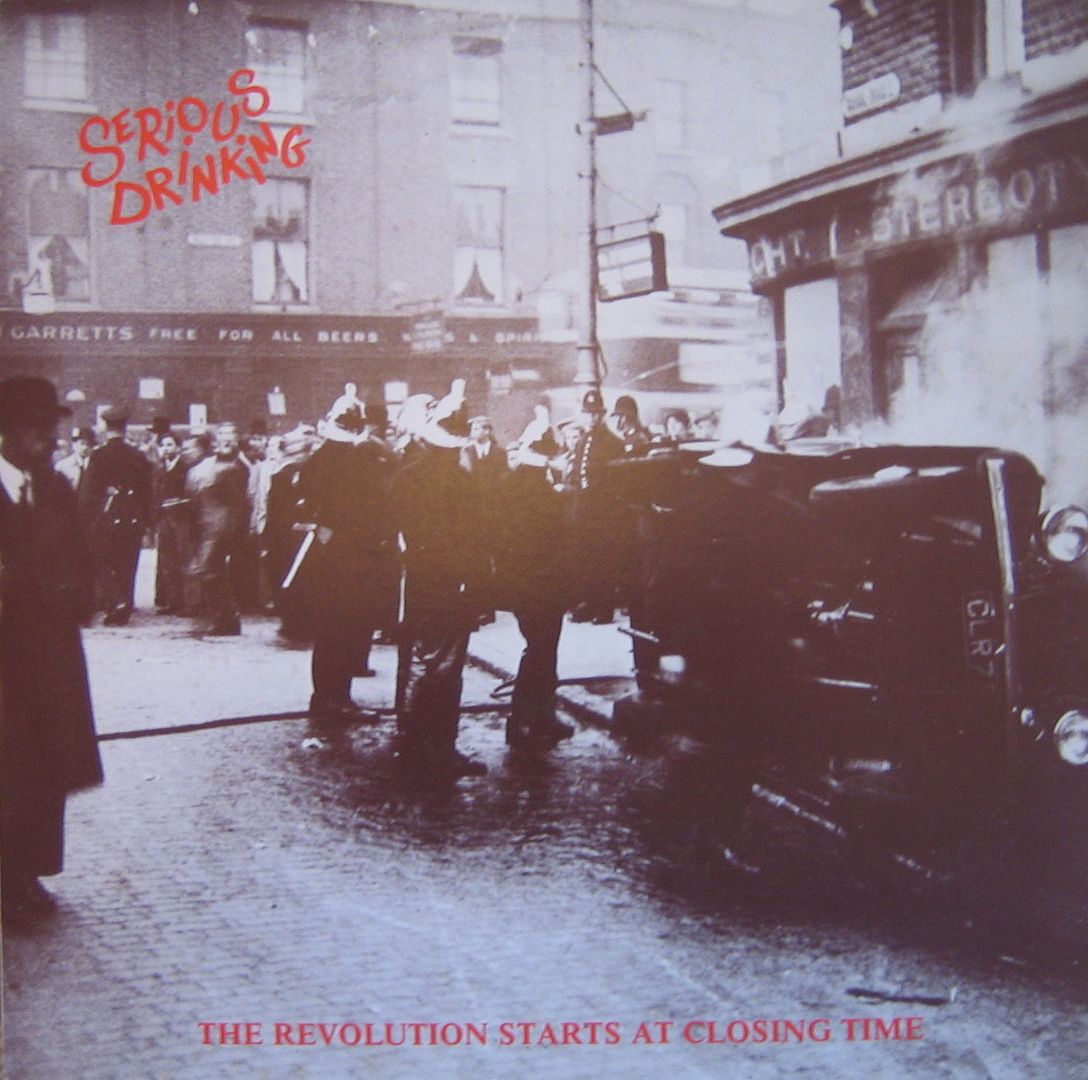

Uploaded tonight is the debut LP by Norwich based band Serious Drinking released on Bill Gilliam’s Upright record label. Bill Gilliam would go on to head the UK wing of Alternative Tenticles records up until the early 1990’s. My standout tracks on this LP are ‘Love On The Terraces’ and ‘Countdown To Bilko’ but it is all decent party stomping fare.
The text below on the band is swiped off wikkid pee dear, and the midwinter pagan festival text is from novareinna.com
WISHING ALL THE KYPP BROWSERS A WARM, SAFE AND HAPPY CHRISTMAS

The band formed in February 1981 in Norwich, taking their name from a Sounds headline to an interview with The Cockney Rejects, with most members having met at the University of East Anglia. Band members were Martin Ling (vocals, formerly of The Higsons), Eugene McCarthy (vocals), Andy Hearshaw (guitar, formerly of The Farmer’s Boys), Jem Moore (bass), and Lance Dunlop (drums). The debut EP, Love On The Terraces (produced by Madness’s Mark Bedford) reached number 9 on the UK Indie Chart in 1982, the follow-up “Hangover” reaching number 4 the following year.
The band were firm favourites of John Peel and recorded four sessions for his BBC Radio One show. “Love On The Terraces” also reached number 38 in the 1982 Festive Fifty.
The debut album ‘The Revolution Starts at Closing Time’ also reached number 4, and was followed up in 1984 by a second album,’ They May Be Drinkers Robin, But They’re Still Human Beings’. After another single, “Country Girl Became Drugs and Sex Punk”, Moore and Dunlop left the band.

The history of a Christmas festival dates back over 4000 years. Ancient Midwinter festivities celebrated the return of the Sun from cold and darkness. Midwinter was a turning point between the Old Year and the New Year. Fire was a symbol of hope and boughs of greenery symbolized the eternal cycle of creation.
The term “Xmas” instead of “Christmas” is Greek in origin. The word for “Christ” in Greek is “Xristos.” during the Sixteenth Century, Europeans began using the first initial of Christ’s name…the “X” of “Xristos”…in place of the word “Christ” as a shorthand version of the word “Christmas.” Although early Christians understood that the “X” was simply another form for the name of Jesus Christ, later Christians, who had no knowledge of the Greek language, mistook “Xmas” as a sign of disrespect. Eventually, however, “Xmas” came to be both an accepted and suitable alternative to the word “Christmas.”
Many of today’s Christmas traditions were celebrated centuries before the Christ Child was born. The Twelve Days of Christmas, blazing fires, the yule log, the giving of gifts, carnivals or parades complete with floats, carolers who sing while going from house to house, holiday feasts and church processions are all rooted in the customs observed by early Mesopotamians.
Many of these traditions began with the Mesopotamian celebration of the New Year. The Mesopotamians worshipped many gods, the chief of whom was Marduk. Each year as winter arrived, it was believed that Marduk would battle the Monsters of Chaos. In order to assist Marduk during his struggle, the Mesopotamians held a festival for the New Year. They called this celebration Zagmuk and the festivities lasted for twelve days.
The King of Mesopotamia would return to the Temple of Marduk and swear his faithfulness to the god. The tradition called for the King to die at the end of the year and then return with Marduk to battle at his side. To spare their King, the Mesopotamians utilized a “mock” king. A criminal was chosen and dressed in royal clothes. He was given all due respect and the privileges of a true king but, at the end of the celebrations, the “mock” king was stripped of the royal garments and then put to death, thus sparing the life of the real monarch.
The ancient Persians and Babylonians celebrated a similar festival which they called the Sacaea. Part of that celebration included the exchanging of places within the community…slaves would become masters and the original masters were obliged to obey the former slaves’ commands.
In Scandinavia during the winter months, the Sun would disappear for great lengths of time. After thirty-five of such dark days, scouts would be dispatched to the mountain tops to await the return of this life-giving heavenly body. When the first light was espied, the scouts would hurry back to their villages bearing the good news. In celebration, a great festival would be held, called the Yuletide, and a special feast would be served around a fire burning with the Yule log. Huge bonfires would also be lit to celebrate the welcome return of the Sun. In some areas, people would tie apples to the branches of trees as a reminder that Spring and Summer would eventually return.
The ancient Greeks held ceremonies similar to those of the Zagmuk and Sacaea festivals. The purpose of this feast was to assist their god Kronos, who would battle against the god Zeus and his army of Titans.
Members of the pagan order have always celebrated the Winter Solstice…the season of the year when days are shortest and nights longest. It was generally believed to be a time of drunkenness, revelry and debauchery. The pagan Romans called this celebration Saturnalia, in honor of their god Saturn. The festivities began in the middle of December and continued until January 1st. On December 25th, “The Birth of the Unconquerable Sun” was celebrated, as the days gradually lengthened and the Sun began to regain its dominance. It is a general pagan belief that the Sun dies during the Winter Solstice and then rises from the dead. With cries of “Jo Saturnalia!”, the Roman celebration would include masquerades in the streets, mangificent festive banquets, the visiting of friends and the exchange of good-luck gifts known as Strenae…or “lucky fruits.” Roman halls would be decked with garlands of laurel and green trees, adorned with lighted candles. Again, as with Sacaea, the masters and slaves would exchange places.
Saturnalia was considered a fun and festive time for the Romans, but Christians believed it an abomination to honor such a pagan god. The early converts wanted to maintain the birthday of their Christ Child as a solemn and religious holiday…not one of cheer and merriment, as was the pagan celebration of Saturnalia.
As Christianity spread, however, the Church became alarmed by the continuing practice among its flock to indulge in pagan customs and celebrate the festival of Saturnalia. At first, the holy men prohibited this type of revelry, but it was to no avail. Eventually, a decision was made to tame such celebrations and make them into a festive occasion better suited to honor the Christian Son of God.
According to some legends, the Christian celebration of Christmas was invented to compete against the pagan festivals held in December. The 25th was sacred not only to the Romans, but also to the Persians whose religion of Mithraism was one of Christianity’s main rivals at that period in time. The Church was, however, finally successful in removing the merriment, lights and gifts from the Saturanilia festival and transferring them to the celebration of a Christian Christmas.
Christmas means “Christ’s Mass” and is the celebration of Jesus Christ’s birth and baptism. Although December 25th is generally accepted as being the time when the Christ Child was born, the exact date has never been chronicled with any degree of accuracy. There is neither scriptural nor secular evidence to establish the exact moment. One thing is relatively certain, however, the event did not take place in December. Since the child was born when shepherds were “abiding in the field, keeping watch over their flocks by night” (Luke 2:8), it is unlikely that shepherds in Israel would have been sleeping outside with their flocks during the month of December. In Winter, the herders would have led their sheep outside only during the daylight hours…the nights would have been far too cold. It is known that during the very early Christian centuries, the birth of the Christ Child was not celebrated in any manner. However, tradition dictates that the occasion has been commemorated since 98 A.D. In 137 A.D., the Bishop of Rome ordered that the birthday of Jesus Christ be observed as a solemn feast. In 350 A.D., Julius I (another Bishop of Rome) selected December 25th as the observance of Christmas. This date was made official in 375 A.D., when it was formally announced that the birth of Jesus would be honored on this day…the announcement also allowed some of the older festivies (such as feasting, dancing and the exchange of gifts) to be incorporated into the observance of Christmas. The use of greenery to decorate homes continued to be prohibited as pagan idolatory but, over the centuries, this too became an accepted custom of the festivies.

My deepest and kindest regards to Clash City Rocker Pete Keeley, late of Norwich, mid to late 1970’s legend at Backs record shop, early 1980’s Rough Trade employee, late 1980’s Shigaku employee, Southern Record Distribution and now Shellshock Distribution honcho who is celebrating his birthday on December 27th. Happy Birthday to you for that day…
In the photograph above Pete is sitting next to Arthur Baker famed producer of ‘Planet Rock’ by Afrika Bambaataa and the Soul Sonic Force, and some time producer of New Order.
DF
December 30, 2010 at 7:08 pmI hate to be a nitpicker but I think it’s Arthur Baker and not Arthur Brown.
Happy new year!
Penguin • Post Author •
December 30, 2010 at 9:09 pmOh dear, how embarrassing…It would not be so bad but this photo was taken in the Fountain next to where Arthur came to visit SRD where I have been for 20 plus years, so really should have written that out correct…I must have been tired…
pete keeley
January 10, 2011 at 2:30 pmActually Pengs,that photo was taken in a Greek restaurant on Upper St, not the Fountain but thanks for the birthday wishes mate
mrg
November 1, 2011 at 7:27 pmI think the side 2 link isn’t working. Side 1 is fine and sounds great. Excellent band-Country Girl Becomes Drugs and Sex Punk was a wonderful single as well
Penguin • Post Author •
November 1, 2011 at 9:43 pmSide two is sorted out now fella.
mrg
November 9, 2011 at 7:59 pmThanks. Sounds as good as I remembered.